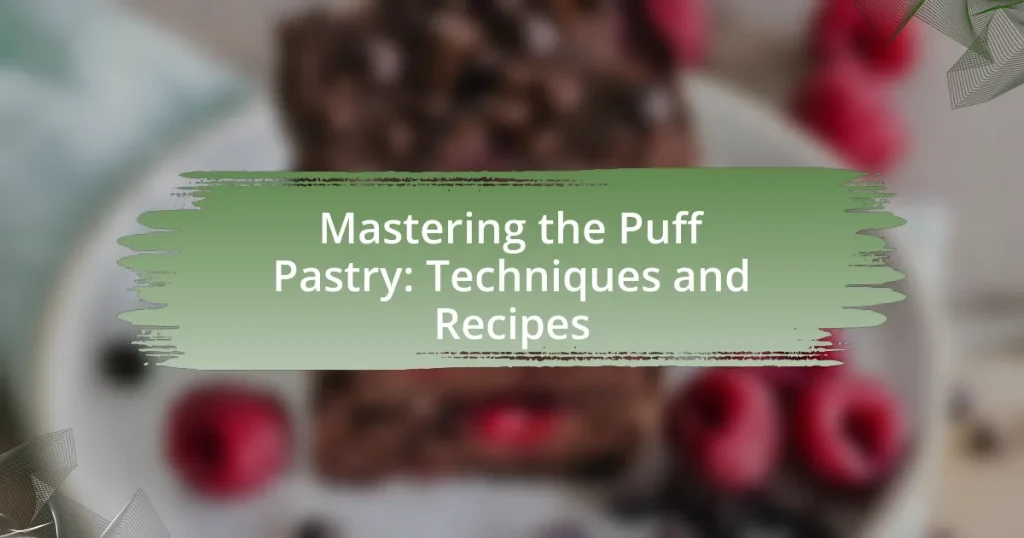Puff pastry is a light, flaky pastry created through a lamination process that layers dough and butter, resulting in a delicate texture ideal for both sweet and savory dishes. This article provides a comprehensive overview of puff pastry, detailing its historical origins, essential ingredients, and key techniques for preparation, including lamination, temperature control, and proper folding methods. Additionally, it explores common uses, classic recipes, and innovative variations, offering practical tips for mastering puff pastry and troubleshooting common issues. The article emphasizes the importance of technique and ingredient quality in achieving the perfect flaky layers that characterize this versatile pastry.

What is Puff Pastry?
Puff pastry is a light, flaky pastry made from layers of dough and butter that create a delicate texture when baked. This pastry is achieved through a process called lamination, where the dough is repeatedly folded and rolled to incorporate air and fat, resulting in its characteristic rise and crispness. Historically, puff pastry dates back to the 17th century in France, where it was refined into the form we recognize today, showcasing its versatility in both sweet and savory dishes.
How is Puff Pastry made?
Puff pastry is made by layering dough and butter through a process called lamination. This involves rolling out a basic dough made from flour, water, and salt, then encasing cold butter within it. The dough is then folded and rolled multiple times, typically in a series of turns, to create numerous layers. Each fold and roll traps air between the layers, which expands during baking, resulting in a flaky and airy texture. The traditional method requires at least six folds, creating hundreds of layers, which is essential for achieving the characteristic rise and texture of puff pastry.
What ingredients are essential for Puff Pastry?
The essential ingredients for puff pastry are flour, water, salt, and butter. Flour provides the structure, while water hydrates the flour to form the dough. Salt enhances flavor and strengthens the dough, and butter is crucial for creating the flaky layers through lamination. The combination of these ingredients allows for the characteristic rise and texture of puff pastry, which is achieved through the steam generated during baking.
What techniques are used in the preparation of Puff Pastry?
The primary techniques used in the preparation of puff pastry include lamination, resting, and rolling. Lamination involves folding layers of dough with butter to create a flaky texture; this is achieved by encasing a block of butter in dough and rolling it out multiple times, typically in a series of folds known as turns. Resting the dough between these turns allows the gluten to relax, which is crucial for achieving the desired flakiness. Rolling is essential to evenly distribute the layers and maintain the correct thickness throughout the process. These techniques are foundational in creating the characteristic rise and texture of puff pastry, which relies on steam generated during baking to separate the layers.
What are the characteristics of Puff Pastry?
Puff pastry is characterized by its flaky, layered texture, achieved through a process of lamination that involves folding and rolling dough with butter. This technique creates multiple layers of dough and fat, which expand during baking due to steam, resulting in a light and airy pastry. The high fat content, typically from butter, contributes to its rich flavor and tender crumb. Additionally, puff pastry is versatile, suitable for both sweet and savory dishes, and can be used in various applications such as tarts, pastries, and pies. The unique combination of these characteristics makes puff pastry a staple in both professional and home kitchens.
How does the layering affect the texture of Puff Pastry?
Layering significantly affects the texture of puff pastry by creating distinct, flaky layers that expand during baking. This process occurs because the layers of dough and butter trap steam, which causes the pastry to rise and develop a light, airy structure. The technique of folding and rolling the dough multiple times, typically involving at least six turns, results in hundreds of layers. Each layer contributes to the final texture, making it crisp on the outside while remaining tender and flaky on the inside. The precise control of temperature and the quality of ingredients, such as the fat content in butter, further enhance this layered effect, ensuring optimal texture in the finished product.
What role does temperature play in Puff Pastry preparation?
Temperature is crucial in puff pastry preparation as it affects the dough’s ability to create layers and achieve flakiness. Cold temperatures keep the butter solid, allowing it to create distinct layers when rolled and folded, which is essential for the pastry’s rise during baking. Specifically, the dough should be kept chilled to prevent the butter from melting into the flour, which would result in a dense texture rather than the desired light and airy structure. Studies show that maintaining a temperature below 60°F (15°C) during the initial mixing and rolling stages significantly enhances the final product’s quality by ensuring proper lamination and steam generation during baking.
What are the common uses of Puff Pastry?
Puff pastry is commonly used for creating a variety of baked goods, including pastries, tarts, and savory dishes. Its unique flaky texture and ability to rise significantly during baking make it ideal for items such as croissants, mille-feuille, and vol-au-vent. Additionally, puff pastry serves as a versatile base for both sweet and savory fillings, allowing for dishes like fruit tarts and meat pies. The dough’s high fat content, typically from butter, contributes to its rich flavor and appealing texture, which is why it is a staple in both professional and home kitchens.
What types of dishes can be made with Puff Pastry?
Puff pastry can be used to create a variety of dishes, including savory items like quiches, tarts, and pot pies, as well as sweet treats such as pastries, turnovers, and éclairs. These dishes leverage the flaky texture and versatility of puff pastry, which is made by layering dough with butter to create a light, airy structure. The use of puff pastry in these dishes is well-documented in culinary practices, with recipes dating back to the 17th century, showcasing its enduring popularity in both home cooking and professional kitchens.
How does Puff Pastry enhance the presentation of a dish?
Puff pastry enhances the presentation of a dish by providing a visually appealing, flaky, and golden-brown crust that elevates the overall aesthetic. The layers of puff pastry create an elegant texture and structure, making dishes look more sophisticated and inviting. Additionally, its ability to hold fillings while maintaining a light and airy appearance contributes to a refined presentation, often seen in gourmet cuisine. The contrast between the crisp exterior and the rich interior draws attention, making the dish more enticing to diners.

What Techniques are Essential for Mastering Puff Pastry?
To master puff pastry, essential techniques include lamination, proper temperature control, and precise folding methods. Lamination involves layering dough and butter to create thin sheets that puff during baking, which is crucial for achieving the desired flaky texture. Maintaining a cool temperature is vital to prevent the butter from melting into the dough, ensuring distinct layers remain intact. Additionally, mastering the folding technique, such as the book fold or letter fold, is necessary to create multiple layers, enhancing the pastry’s rise and flakiness. These techniques are foundational in professional baking, as evidenced by their consistent application in culinary schools and pastry competitions worldwide.
How do you achieve the perfect layers in Puff Pastry?
To achieve the perfect layers in puff pastry, it is essential to create a proper lamination process, which involves folding and rolling dough with butter multiple times. This technique creates distinct layers of dough and butter that expand during baking, resulting in a flaky texture. The key is to maintain a consistent temperature; the dough and butter should be cold to prevent the butter from melting into the dough. Additionally, using equal parts of dough and butter, typically a 3:1 ratio, ensures that the layers remain distinct. Proper resting periods between folds allow the gluten to relax, further enhancing the flakiness.
What is the importance of folding and rolling in Puff Pastry?
Folding and rolling are crucial in puff pastry as they create layers that result in its characteristic flakiness and rise. The process involves encasing butter in dough and repeatedly rolling and folding it, which develops gluten and traps air. This technique is essential because it allows steam to form during baking, causing the layers to separate and puff up. The traditional method typically requires at least six folds, leading to hundreds of layers, which is why puff pastry achieves its light and airy texture.
How can you prevent the dough from becoming tough?
To prevent the dough from becoming tough, ensure that you handle it gently and avoid overworking it. Overworking the dough develops gluten, which can lead to toughness. Additionally, using cold ingredients and chilling the dough before rolling helps maintain its tenderness by preventing the fat from melting too quickly, which is crucial in puff pastry. This technique is supported by culinary principles that emphasize the importance of temperature control and minimal handling in achieving a flaky texture.
What tips can improve your Puff Pastry skills?
To improve your puff pastry skills, focus on maintaining a consistent temperature for your ingredients and workspace. Cold butter and chilled dough are essential for creating the distinct layers in puff pastry, as the cold fat creates steam during baking, leading to a flaky texture. Additionally, practice the folding technique; a standard method involves folding the dough into thirds, rolling it out, and repeating this process several times to develop the layers. This technique is supported by culinary experts who emphasize that proper lamination is crucial for achieving the desired rise and flakiness in the final product.
How can you troubleshoot common Puff Pastry issues?
To troubleshoot common puff pastry issues, first identify the specific problem, such as lack of rise, sogginess, or uneven layers. For lack of rise, ensure that the dough is chilled properly before baking, as cold butter creates steam that helps puff the pastry. If the pastry is soggy, check that the filling is not too wet and that the pastry is baked on a preheated baking sheet to promote crispness. For uneven layers, roll the dough evenly and avoid overworking it, as this can lead to a dense texture. These troubleshooting steps are supported by the fundamental principles of pastry making, which emphasize the importance of temperature control and proper technique in achieving the desired flaky texture.
What are the best practices for storing Puff Pastry?
The best practices for storing puff pastry involve keeping it in a cool, dry place and ensuring it is well-wrapped to prevent exposure to air. Puff pastry should be stored in the refrigerator if it will be used within a few days, wrapped tightly in plastic wrap or placed in an airtight container to maintain its moisture and prevent it from absorbing odors. For longer storage, puff pastry can be frozen; it should be wrapped in plastic wrap and then placed in a freezer bag or airtight container to prevent freezer burn. Properly stored, puff pastry can last up to three months in the freezer. These methods help preserve the pastry’s flaky texture and prevent spoilage.

What Recipes Can You Try with Puff Pastry?
Puff pastry can be used to create a variety of delicious recipes, including savory dishes like spinach and feta pastries, chicken pot pie, and cheese straws, as well as sweet treats such as fruit tarts, palmiers, and chocolate croissants. These recipes leverage the flaky texture and buttery flavor of puff pastry, which is achieved through a process of layering dough and butter. The versatility of puff pastry allows it to be baked into both appetizers and desserts, making it a staple in many culinary traditions.
What are some classic Puff Pastry recipes?
Classic puff pastry recipes include Croissants, which are flaky, buttery pastries made by layering dough with butter and rolling it out multiple times; Puffs, which are light, airy pastries often filled with cream or custard; and Beef Wellington, a savory dish featuring beef tenderloin coated with pâté and wrapped in puff pastry. These recipes showcase the versatility of puff pastry, which has been a staple in French cuisine since the 17th century, highlighting its ability to create both sweet and savory dishes.
How do you make a traditional Puff Pastry tart?
To make a traditional Puff Pastry tart, begin by preparing the puff pastry dough, which consists of flour, water, salt, and butter, layered through a process called lamination. This involves rolling out the dough, folding it multiple times to create layers, and chilling it between folds to ensure the butter remains cold and creates steam during baking. Once the dough is ready, roll it out to fit a tart pan, trim the edges, and dock the base with a fork to prevent bubbling. Pre-bake the crust at 400°F (200°C) for about 15 minutes until lightly golden. After cooling, fill the tart with desired ingredients, such as custard or fruit, and bake again until the filling is set. This method is validated by traditional French pastry techniques, which emphasize the importance of cold ingredients and precise layering for achieving the characteristic flaky texture of puff pastry.
What is the process for creating Puff Pastry appetizers?
The process for creating Puff Pastry appetizers involves several key steps: preparing the dough, laminating it, and shaping it into desired forms. First, the dough is made by combining flour, water, salt, and butter, then chilled. Next, the lamination process begins by rolling out the dough and folding in layers of butter, which creates the flaky texture. This rolling and folding is repeated multiple times, typically six to eight, to achieve the desired number of layers. Finally, the laminated dough is cut into shapes, filled with various ingredients, and baked until golden brown. This method is essential for achieving the characteristic puff and flakiness of the pastry, which is a result of steam created during baking.
What innovative Puff Pastry recipes can you explore?
Innovative puff pastry recipes to explore include savory options like spinach and feta puffs, which combine flaky pastry with a rich filling, and sweet variations such as chocolate croissants, where the pastry envelops melted chocolate for a decadent treat. Additionally, you can try making puff pastry tarts topped with seasonal fruits and custard, or create bite-sized appetizers like puff pastry pinwheels filled with pesto and cheese. These recipes highlight the versatility of puff pastry, allowing for both sweet and savory creations that can be tailored to various tastes and occasions.
How can you incorporate seasonal ingredients into Puff Pastry dishes?
Incorporating seasonal ingredients into Puff Pastry dishes can be achieved by selecting fresh produce that is at its peak during specific times of the year. For example, in spring, asparagus and peas can be used to create a light filling, while in autumn, pumpkin and apples can add warmth and richness. Seasonal ingredients not only enhance flavor but also provide nutritional benefits, as they are often harvested at their ripest. Utilizing these ingredients in combination with herbs that complement their flavors, such as thyme with asparagus or cinnamon with apples, can elevate the dish further. This approach aligns with culinary practices that emphasize freshness and locality, making Puff Pastry dishes more vibrant and appealing.
What are some unique dessert recipes using Puff Pastry?
Unique dessert recipes using puff pastry include Apple Tart Tatin, which features caramelized apples atop a flaky pastry base, and Chocolate Croissants, where rich chocolate is enveloped in layers of buttery pastry. Another option is the Raspberry Cream Puffs, combining light pastry shells filled with raspberry-infused cream. Additionally, you can create Palmiers, which are crispy, caramelized pastries made from rolled puff pastry and sugar. Each of these recipes showcases the versatility of puff pastry in creating delightful desserts.
What are the best tips for baking Puff Pastry successfully?
To bake puff pastry successfully, ensure that the dough remains cold throughout the process. Keeping the butter and dough chilled prevents the fat from melting before baking, which is crucial for achieving the desired flaky layers. Additionally, roll the pastry evenly to maintain consistent thickness, as uneven rolling can lead to uneven baking. Preheating the oven to a high temperature, typically around 400°F to 425°F, is essential, as this helps create steam quickly, allowing the layers to rise effectively. Finally, using an egg wash before baking enhances browning and gives the pastry a beautiful finish. These techniques are supported by culinary experts who emphasize the importance of temperature control and even rolling in achieving optimal puff pastry results.




